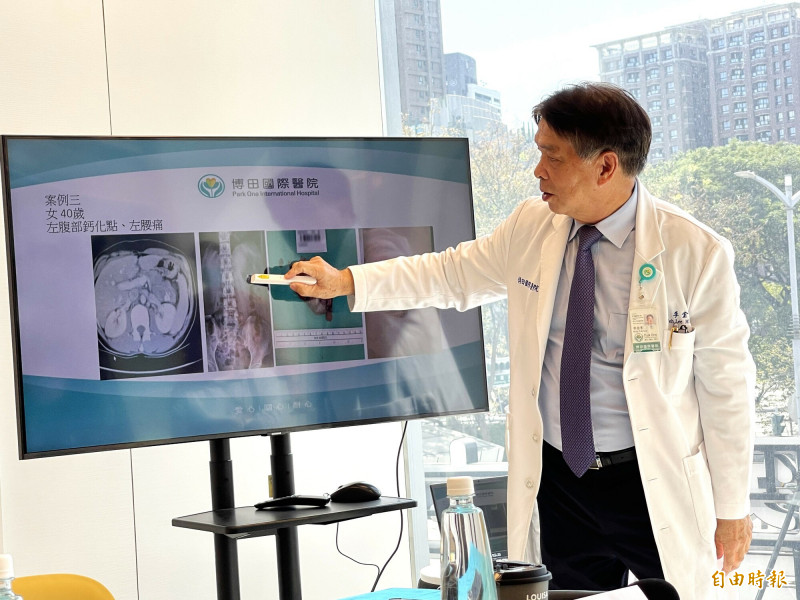Professor Li Jinde of the Department of Hepatobiliary and Pancreatic Surgery pointed out that Ms. Guo found calcifications in her abdomen during her health checkup. She thought it was a kidney stone, but after further examination, she found out that it was a tumor in the body and tail of the pancreas.
(Photo by reporter Xu Lijuan)
[Reporter Xu Lijuan/Kaohsiung Report] Ms. Guo, an office worker, found a suspected 2 cm stone in her abdomen during her medical examination at the end of last year. Further examination revealed a malignant solid pseudopapillary tumor of the pancreas growing at the tail of the pancreas. Regarding this, the doctor reminded that recently Resected malignant pancreatic cancer tumors for 3 women in a row for 1 month, and all of them were non-solid pancreatic cysts. All 3 of them claimed to be asymptomatic. Although pancreatic cancer is not easy to be found in the early stage, pancreatic cysts can be found in the examination And continuous tracking, appeals must not be ignored.
Ms. Guo, 40 years old this year, said that she lives a regular life, eats normally, and has no bad habits, but she did not expect to be found by "cancer" silently. I arranged for an examination during my work break, but found that there was a suspected 2 cm stone in the left abdomen. I went to the teaching hospital at the beginning of this year and went to the teaching hospital for computer tomography scan.
Please read on...
Ms. Guo was introduced by a friend to Hakata International Hospital to seek treatment from Professor Li Jinde, a retired senior hepatobiliary and pancreatic surgeon. MRI examinations revealed that the tumor was located at the tail of the pancreas and was likely to spread to the spleen. She originally planned to remove the spleen at the same time, but failed during the operation. It was found that it did not spread to the spleen and was preserved, but the tumor was confirmed as a malignant tumor by pathological section. It is a cystic and rare solid pseudopapillary tumor of the pancreas. Due to early detection and treatment, the 5-year survival rate can reach 95-97% .
Ms. Guo found calcifications in the abdomen (red circle in the picture). Fortunately, she was vigilant enough for further examination and was found to be a solid pseudopapillary tumor of the pancreas at an early stage.
(Provided by Li Jinde)
In this regard, Li Jinde said that the morphology of pancreatic cancer can be divided into solid and cystic. Solid includes pancreatic ductal adenocarcinoma and neuroendocrine tumors, which are the most common but cannot be detected early. Ductal adenocarcinoma, mucinous cyst, solid pseudomastoid tumor, and cystic neuroendocrine tumor can be detected by ultrasound or computerized tomography. 20% of them will become cancer within 10 years. If they are detected early and have not metastasized to Lymph, the survival rate within 5 years is quite high, but when the cyst becomes larger, even larger than 4 cm and has metastasized to lymph or other internal organs, the survival rate may be less than 20%.
Li Jinde further explained that for the three cases of pancreatic cysts that underwent surgery in February, Ms. Guo was considered lucky to have detected and treated them early, and did not metastasize to the lymph nodes. Surgical resection is all that is needed, but 8% of them will metastasize in the future and need to be continued. Follow-up; the other case was a 72-year-old female with abdominal distension and long-term left abdominal pain. CT scan revealed a 5X6 cm tumor in the body and tail of the pancreas. She was diagnosed with pancreatic ductal carcinoma and lymphatic metastasis. Chemotherapy was required after surgical resection, and the 5-year survival rate was only 3.2 -8%; the third case was a 58-year-old female with epigastric pain and diabetes. A small pancreatic cyst was detected 2 years ago. Computer tomography revealed a 6X7 cm tumor in the body and tail of the pancreas. It was diagnosed as mucinous carcinoma of the pancreas. Combined with liver and lymphatic metastasis, chemotherapy is required after surgical resection, and the 5-year survival rate is about 11.5-23.6%.
Li Jinde reminded that although patients claim to be asymptomatic, most of them will experience heart discomfort or pain that is drawn to the back, or symptoms such as heart-gnawing pain, dull pain, or backache should be paid attention to, and those that cause pancreatic cancer Factors include pancreatic tumors, newly discovered diabetes or sudden exacerbation of diabetes, being too fat and not exercising, and a small part of it is genetic, alcoholic pancreatitis caused by drinking, smoking, etc. It is recommended to have regular health checkups. If a cyst is found, follow-up should be continued to prevent it from becoming pancreatic cancer.
Patient Ms. Guo (middle), accompanied by Ruan Lanting (left), Vice President of Botian Hospital, and Li Jinde (right), Professor of Hepatobiliary and Pancreatic Surgery, appealed for the importance of health checks. If a pancreatic cyst is found, it should be further checked and followed up .
(Photo by reporter Xu Lijuan)
☆Health news will never be missed, click like to follow the fan page.
☆For more important medical news, please go to Liberty Health.com.
keywords
the tumor
smokes
pancreatic cancer
pancreas
related news
